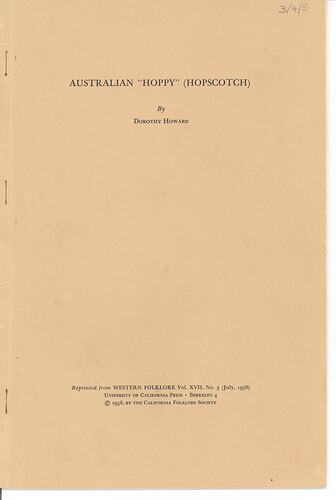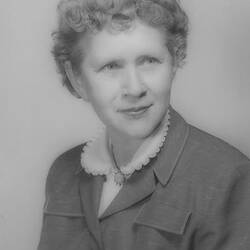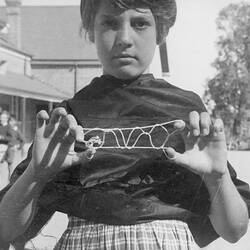Summary
Game names (and types): Hopscotch, 'Hoppy', 'Base Hoppy', 'Kick Hoppy', 'Snail Hoppy', 'Spider Web', 'Aeroplane Hoppy', 'Apple Hoppy', 'Base Hoppy', 'Circle', 'Circle Hoppy', 'Colours', 'Devil Hoppy', 'Geography Hoppy', 'Hop Squares', 'Horseshoe Hoppy', 'Kick-A-Taw', 'Mountain, Valley, Lake, River', 'North, South, East, West', 'River Hoppy', 'Round Hoppy', 'Shop Hoppy', 'Snake Hoppy', 'Square Hoppy', 'Yacht Hoppy' (Hopscotch, taw use, patterns)
Alternative game types: jumping games, play with equipment/types
Article titled 'Australian "Hoppy" (Hopscotch)' written by Dr Dorothy Howard and reprinted from Western Folklore in 1958. Dr Howard discusses the variations of Hopscotch patterns - the chalk markings usually drawn on pavements - across Australia, known colloquially as 'Hoppy'. She examines the regional differences in terminology and ways of playing. The article also includes illustrations of each pattern described. Dr Howard received written reports and demonstrations from numerous children including Gwennyth ?, Heather ?, Jill ?, Anne?, Sandra ?, Carole ?, Roger ?, Pam ?, Joan ?, Suzanne ?, Dorothy ?, Janet ?, Carolyn ?, Pamela ?, Gay ?, Judith ?, Fay ?, Rosalind ?, Roseleen ?, Narvelle ?, Poppy ?, Zina ? and Cliff?. Other examples were provided by adults including Gladys Beckham, Margaret Outridge, Miss B. Ford-Smith, Adrien Bieske, Mary Howie, Mrs Jennings, Dr Michael Grounds, Mr C. D. Hancox, Mr and Mrs Howe, and Mr and Mrs Campbell.
One of a collection of publications about children's folklore written by Dr Dorothy Howard. Dr Howard came to Australia in 1954-55 as an American Fulbright scholar to study Australian children's folklore. She travelled across Australia for 10 months collecting children's playground rhymes, games, play artefacts, etc. The original fieldwork she collected during this period is held in the Australian Children's Folklore Collection (ACFC) at Museum Victoria and includes index cards, letters and photographs.
Physical Description
Article with typed black text printed on paper; includes diagrams. Four pages printed on both sides and folded to create a booklet. Inside light brown cardboard cover.
More Information
-
Collection Names
Australian Children's Folklore Collection, Dorothy Howard Collection
-
Collecting Areas
-
Acquisition Information
Cultural Gifts Donation from Dr June Factor, 18 May 1999
-
Acknowledgement
Donated through the Australian Government's Cultural Gifts Program.
-
Collector
-
Author
-
Publisher
Western Folklore, California, United States of America, Jul 1958
-
Place & Date of Event
Australia, 1954-1955
This publication is based on material gathered by Dr. Howard during her research trip to Australia between 1954-55. -
Organisation Named
La Perouse School, Sydney, Greater Sydney, New South Wales, Australia, 1954-1955
-
Organisation Named
East Camberwell Girls' Secondary School (College), Melbourne, Greater Melbourne, Victoria, Australia, 1954-1955
-
Organisation Named
Ainslie School, Canberra, Greater Canberra, Australian Capital Territory, Australia, 1954-1955
-
Organisation Named
Mt Barker Primary School, Mount Barker, South Australia, Australia, 1954-1955
-
Organisation Named
Carlisle Government Primary School, Carlisle, Greater Perth, Western Australia, Australia, 1954-1955
-
Organisation Named
Collier Government Primary School, Perth, Greater Perth, Western Australia, Australia, 1954-1955
-
Organisation Named
St Hilda's Church of England Girls' School, Perth, Greater Perth, Western Australia, Australia, 1954-1955
-
Organisation Named
St Helens Area School, St Helens, Tasmania, Australia, 1954-1955
-
Organisation Named
East Fremantle Government Primary School, Fremantle, Greater Perth, Western Australia, Australia, 1954-1955
-
Classification
-
Category
-
Discipline
-
Type of item
-
Overall Dimensions
171 mm (Width), 254 mm (Height)
Orientation: portrait
-
Keywords


